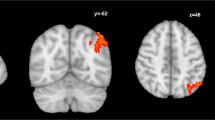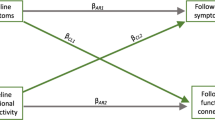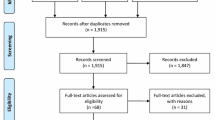Abstract
Comparison of the neuropsychological performances of ADD children and matched controls revealed a relatively circumscribed pattern of deficits on tests presumed to measure frontal lobe inhibitory control. Age trends were noted on several variables, suggesting a possible maturational lag in frontal lobe functioning among the ADD subjects. Physician ratings of medication response and fit with DSM-III criteria for ADD, along with Parent and Teacher Conners' ratings, were also related to the ADD children's neuropsychological test scores. The results are discussed in terms of the potential overlap of hyperactivity with disorders of disinhibition such as conduct disorder.
Similar content being viewed by others
Explore related subjects
Discover the latest articles and news from researchers in related subjects, suggested using machine learning.References
Ullman DG, Egan D, Fielder N, et al.: The many faces of hyperactivity: Similarities and differences in politics.J Consult Clin Psychol 49:694–704, 1981.
Trites RL, Laprade L: Evidence for an independent syndrome of hyperactivity.J Child Psychol Psychiat 24:573–586, 1983.
Laufer MW, Denhoff EH, Solomons GT: Hyperkinetic impulse disorder in children's behavior problems.Psychosom Med 19:38–49, 1957.
Wender PH:Minimal Brain Dysfunction in Children. New York, Wiley-Interscience, 1971.
Satterfield JH: Neurophysiologic studies with hyperactive children, inThe Hyperactive Child, Cantwell DP (Ed.). New York, Spectrum, 1975.
Rapoport JL, Buchsbaum MS, Weingartner H, et al.: Dextroamphetamine: Cognitive and behavioral effects in normal and hyperactive boys and normal men.Arch Gen Psychiatry 37:933–946, 1980.
Rapoport JL, Buchsbaum MS, Zahn TP, et al.: Dextroamphetamine: Cognitive and behavioral effects in normal and prepubertal boys.Science 199:560–563, 1978.
Conners CK, Eisenberg L, Sharpe L: Effects of methylphenidate (Ritalin) on pairedassociate learning and Porteus Maze performance in emotionally disturbed children.J Consult Psychol 28:14–22, 1964.
Dykman RA, Ackerman PT, Clements SD, et al.: Specific learning difficulties: An attentional deficit syndrome, inProgress in Learning Disabilities (Vol. 2), Myklebust HR (Ed.). New York, Grune & Stratton, 1971.
Mattes JA: The role of frontal lobe dysfunction in childhood hyperkinesis.Compr Psychiatry 21:358–369, 1980.
Fuster JM:The Prefrontal Cortex: Anatomy, Physiology, and Neuropsychology of the Frontal Lobe. New York, Raven, 1980.
Luria AR:The Working Brain. New York, Basic Books, 1973.
Grueninger W, Grueninger J: The primate frontal cortex and allassostasis, inPsychophysiology of the Frontal Lobe, Pribram KH and Luria AR (Eds). New York, Academic Press, 1973.
Numan R: Cortical-limbic mechanisms and response control: A theoretical review.Physiol Psychol 6:445–470, 1978.
Benson DF, Stuss DT: Motor abilities after frontal leukotomy.Neurology 32: 1353–1357, 1982.
Drewe EA: Go-no go learning after frontal lobe lesions in humans.Cortex 11:8–16, 1975.
Gorenstein EE: Frontal lobe functions in psychopaths.J Abnorm Psychol 91: 368–379, 1982.
Milner B: Effects of different brain lesions on card sorting.Arch Neurol 9:90–100, 1963.
Petrides M, Milner B: Deficits on subject-ordered tasks after frontal and temporal lobe lesions in man.Neuropsychologia 20:249–262, 1982.
Hecaen H, Albert ML:Human Neuropsychology. New York, Wiley.
Konorski J:Integrative Activity of the Brain: An Interdisciplinary Approach. Chicago, University of Chicago Press, 1967.
Fletcher JM, Taylor HG: Neuropsychological approaches to children: Towards a developmental neuropsychology.J Clin Neuropsychol 6:39–56, 1984.
Rosenthal RH, Allen TW: An examination of attention, arousal, and learning dysfunction of hyperkinetic children.Psychol Bull 85:689–715, 1978.
Golden, CJ: The Luria-Nebraska Children's Battery: Theory and formulation, inNeuropsychological Assessment of the School Aged Child, Hynd GW and Obrzut JE (Eds.) New York, Grune & Stratton, 1981.
Chelune GJ, Baer RA: Developmental norms for the Wisconsin Card Sorting Test.J Clin Exp Neuropsychol, in press.
Passler MA, Isaac W, Hynd GW: Neuropsychological development of behavior attributed to frontal lobe functioning in children.Dev Neuropsychol, 1, 349–370, 1985.
Heaton RK:The Wisconsin Card Sorting Test Manual. Odessa, FL, Psychological Assessment Resources, 1981.
Dunn LM, Dunn LM:Peabody Picture Vocabulary Test-Revised Manual. Circle Pines, MN, American Guidance Service, 1981.
Kaufman AS, Kaufman NL:Kaufman Assessment Battery for Children Interpretative Manual. Circle Pines, MN, American Guidance Service, 1983.
Reitan RM, Davison LA:Clinical Neuropsychology: Current Status and Applications. New York, Wiley, 1974.
Horowitz LM, Inouye D, Siegleman EY: On averaging judges' ratings to increase their correlation with an external criterion.J Consult Clin Psychol 47:453–458, 1979.
Alabiso F: Inhibitory functions of attention in reducing hyperactive behavior.Am J Ment Defic 77:259–282.
Das JP, Kirby J, Jarman RF: Simultaneous and successive syntheses: An alternative model for cognitive abilities.Psychol Bull 82:87–103, 1975.
Das JP: Simultaneous and successive processes and K-ABC.J Special Educ 18: 229–238, 1984.
Calloway E, Halliday R, Naylor H: Hyperactive children's event-related potentials fail to support underarousal and maturational-lag theories.Arch Gen Psychiatry 40: 1243–1248, 1983.
Satterfield JH, Braley BW: Evoked potentials and brain maturation in hyperactive and normal children.Electroencephalogr Clin Neurophysiol 43:43–51, 1977.
Rapoport JL, Ferguson HB: Biological validation of the hyperkinetic syndrome.Dev Med Child Neurol 23:667–682, 1981.
Millichap JG, Johnson FH: Methylphenidate in hyperkinetic behavior: Relation of response to degree of activity and brain damage.Exerpta Medica 313:202–213, 1974.
Schachar R, Rutter M, Smith A: The characteristics of situationally and pervasively hyperactive children: Implications for syndrome definition.J Child Psychol Psychiat 22:375–392, 1981.
Cohn NJ, Minde K: The ‘hyperactive syndrome’ in kindergarten children: Comparison of children with pervasive and situational symptoms.J Child Psychol Psychiat 24:443–455, 1983.
Loney J, Milich RS: Hyperactivity, inattention, and aggression in clinical practice, inAdvances in Behavioral Pediatrics (Vol. 2), Wolraich M and Routh DK (Eds.). Greenwich, CT, JAI Press, 1981.
Ross DM, Ross SA:Hyperativity: Current Issues, Research, and Theory. New York, Wiley, 1982.
Ponitus AA, Ruttigier, KF: Frontal lobe system maturational lag in juvenile delinquents shown in Narratives Test.Adolescence 44:509–518, 1976.
Dykman RA, Ackerman PT, McCray DS: Effects of methylphenidate on selective and sustained attention in hyperactive, reading disabled, and presumably attention-disordered boys.J Nerv Ment Dis 168:745–752, 1980.
Loney J, Kramer J, Milich R: The hyperactive child grows up: Predictors of symptoms, delinquency, and achievement at follow-up, inPsychosocial Aspects of Drug Treatment for Hyperactivity, Gadow KD and Loney J (Eds.), Boulder, CO, Westview Press, 1981.
McGee R, Williams S, Silva PA: Behavioral and developmental characteristics of aggressive, hyperactive, and aggressive-hyperactive boys.J Am Acad Child Psychiatry 23:270–279, 1984.
Author information
Authors and Affiliations
Rights and permissions
About this article
Cite this article
Chelune, G.J., Ferguson, W., Koon, R. et al. Frontal lobe disinhibition in attention deficit disorder. Child Psych Hum Dev 16, 221–234 (1986). https://doi.org/10.1007/BF00706479
Issue Date:
DOI: https://doi.org/10.1007/BF00706479




